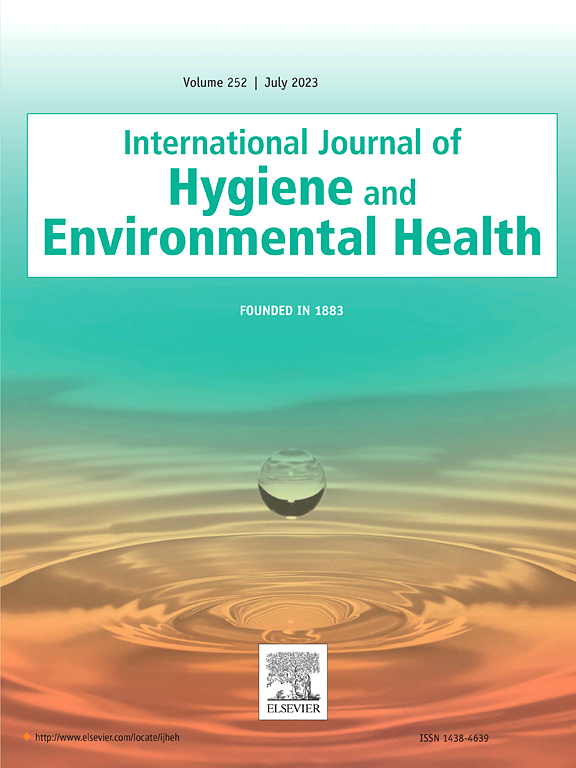Associations between metal/metalloid exposure during pregnancy and placental growth characteristics: Findings from the Hangzhou birth cohort study II
IF 4.5
2区 医学
Q1 INFECTIOUS DISEASES
International journal of hygiene and environmental health
Pub Date : 2024-09-28
DOI:10.1016/j.ijheh.2024.114470
引用次数: 0
Abstract
Previous studies have suggested that metal/metalloid (hereafter referred to as metal) exposure may influence placental growth by affecting gene expression in the placenta. However, no epidemiological studies have been conducted to validate the relationships between metals exposure, placental gene expression, and placental growth at the population level. This study aims to investigate these relationships based on Hangzhou birth cohort study II (HBCS-II). Totally, 1025 participants were derived from HBCS-II. Thirteen metals levels in the placenta were measured using inductively coupled plasma mass spectrometry. Placental growth characteristics were assessed, including placental weight, chorionic disc area, placental eccentricity, and distance from cord insertion site to the nearest edge of placenta (DCIEP). The relationships between metals exposure and placental growth characteristics were examined using the elastic net model combined unpenalized linear regression model. Placental gene expression levels were analyzed through RNA sequencing and real-time polymerase chain reaction (RT-qPCR), and mediation analysis was conducted to investigate whether placental gene expression could mediate the relationship between metal exposure and placental growth. Notably, the results showed that a unite increase in Ln-transformed cadmium (Cd) levels was associated with a reduction of 16.4 g [95% confidence interval (CI): 31.2, −1.5] in placental weight, 13.9 cm2 (95%CI: 20.0, −7.8) in chorionic disc area, and 0.3 cm (95%CI: 0.55, −0.06) in DCIEP. Through RNA sequencing followed by validation, significant associations were observed between placental Cd level and increased expression of placental genes, including TNFAIP2, OLAH, FLT4, SH3PXD2A, LIMCH1, BCL6, SLCO2A1, and CPSF1. Additionally, increased placental TNFAIP2, OLAH, FLT4, SH3PXD2A and LIMCH1 expression was linked to reduced placental weight. Moreover, SH3PXD2A was associated with decreased chorionic disc area. Mediation analysis showed that placental Cd level was associated with a 12.0 g (95%CI: 23.8, −2.7) decrease in placental weight mediated through the upregulation of FTL4 gene expression. The study provides evidence of the association between placental Cd exposure and decreased placental weight, and the FLT4 gene may play a mediating role in this relationship. Future experiment studies should be performed to validate the results.
孕期金属/类金属暴露与胎盘生长特征的关系:杭州出生队列研究II的结果。
以往的研究表明,金属/类金属(以下简称金属)暴露可能会通过影响胎盘中的基因表达来影响胎盘的生长。然而,目前还没有流行病学研究在人群水平上验证金属暴露、胎盘基因表达和胎盘生长之间的关系。本研究以杭州出生队列研究 II(HBCS-II)为基础,旨在探究这些关系。杭州出生队列研究II共有1025名参与者。采用电感耦合等离子体质谱法测量了胎盘中 13 种金属的含量。对胎盘生长特征进行了评估,包括胎盘重量、绒毛盘面积、胎盘偏心率以及从脐带插入部位到胎盘最近边缘的距离(DCIEP)。采用弹性网模型结合非衰减线性回归模型研究了金属暴露与胎盘生长特征之间的关系。通过 RNA 测序和实时聚合酶链反应(RT-qPCR)分析了胎盘基因表达水平,并进行了中介分析,研究胎盘基因表达是否能中介金属暴露与胎盘生长之间的关系。值得注意的是,结果显示镧转化镉(Cd)水平每增加1倍,胎盘重量就会减少16.4克[95%置信区间(CI):31.2,-1.5],绒毛盘面积减少13.9平方厘米(95%CI:20.0,-7.8),DCIEP减少0.3厘米(95%CI:0.55,-0.06)。通过 RNA 测序和验证,观察到胎盘镉水平与胎盘基因(包括 TNFAIP2、OLAH、FLT4、SH3PXD2A、LIMCH1、BCL6、SLCO2A1 和 CPSF1)表达增加之间存在显著关联。此外,胎盘 TNFAIP2、OLAH、FLT4、SH3PXD2A 和 LIMCH1 表达的增加与胎盘重量的减少有关。此外,SH3PXD2A 与绒毛膜盘面积减少有关。中介分析表明,胎盘镉水平与胎盘重量减少 12.0 克(95%CI:23.8,-2.7)相关,而胎盘重量的减少是通过 FTL4 基因表达上调介导的。该研究提供了胎盘镉暴露与胎盘重量下降之间相关性的证据,而FLT4基因可能在这种关系中起中介作用。未来的实验研究应验证这些结果。
本文章由计算机程序翻译,如有差异,请以英文原文为准。
求助全文
约1分钟内获得全文
求助全文
来源期刊
CiteScore
11.50
自引率
5.00%
发文量
151
审稿时长
22 days
期刊介绍:
The International Journal of Hygiene and Environmental Health serves as a multidisciplinary forum for original reports on exposure assessment and the reactions to and consequences of human exposure to the biological, chemical, and physical environment. Research reports, short communications, reviews, scientific comments, technical notes, and editorials will be peer-reviewed before acceptance for publication. Priority will be given to articles on epidemiological aspects of environmental toxicology, health risk assessments, susceptible (sub) populations, sanitation and clean water, human biomonitoring, environmental medicine, and public health aspects of exposure-related outcomes.

 求助内容:
求助内容: 应助结果提醒方式:
应助结果提醒方式:


